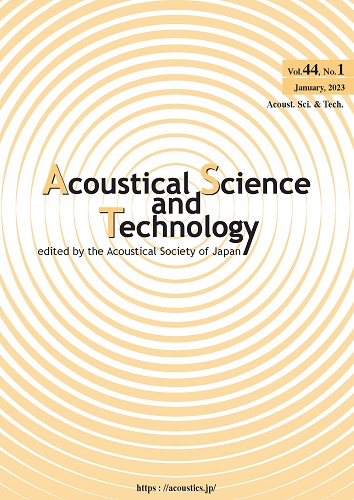
- |<
- <
- 1
- >
- >|
-
Jungsoon Kim, Moojoon Kim2023Volume 44Issue 1 Pages 1-8
Published: January 01, 2023
Released on J-STAGE: January 01, 2023
JOURNAL FREE ACCESSThe vibration mode of a bolt-clamped ultrasonic transducer was experimentally analyzed. In the experiment, a designed and manufactured semicircular wedge-shaped jig was used to apply constant pressure to a narrow band-shaped area on the lateral side of the transducer. Constant force was applied to the jig with a vise and a torque wrench. As the position of the pressure applied by the jig moved along the length of the transducer, the change of the input admittance characteristic of the transducer was observed. Each vibration mode was analyzed from the change in the magnitude and the resonant frequency of the input admittance. The proposed method made it possible to practically determine the position of the node for each vibration mode, and is expected to provide useful information to utilize the harmonic modes.
View full abstractDownload PDF (1278K) -
Hironori Takemoto, Seiji Adachi, Natsuki Toda2023Volume 44Issue 1 Pages 9-16
Published: January 01, 2023
Released on J-STAGE: January 01, 2023
JOURNAL FREE ACCESSThe vocal tract can be modeled as an acoustic tube in the low-frequency region because the plane wave propagation is dominant. Further, it can be considered static for a limited short period during running speech, such as vowels. Thus, its acoustic properties have been examined mainly using the transmission line model (TLM), that is, the one-dimensional static model in the frequency domain. In the present paper, we propose a one-dimensional static model in the time domain based on the finite-difference time-domain method. In this model, the vocal tract is represented by the cascaded acoustic tubes of different cross-sectional areas. The pressure and wall vibration effects are simulated at the center of each tube. On the other hand, the volume velocity is calculated at the labial end. According to the leapfrog algorithm, the pressure and volume velocity are sequentially computed. As a result, the impulse responses of the vocal tracts for the five Japanese vowels were calculated, and the corresponding transfer functions agreed well with those calculated by the TLM in the low-frequency region. The mean absolute percentage difference of the lower four peaks for the five vowels was 2.3%.
View full abstractDownload PDF (684K)
-
Shinichi Sakamoto, Wenrui Xu, Taiki Fukuda, Miki Yonemura2023Volume 44Issue 1 Pages 17-23
Published: January 01, 2023
Released on J-STAGE: January 01, 2023
JOURNAL FREE ACCESSRoad traffic noise calculation method behind buildings included in the ASJ RTN-Model 2018 is an empirical model formula based on experimental results of a scale model. Therefore, the scope of the calculation method is formally limited in terms of building height, density, and distance from the road, dependent on the range of the experimental conditions. However, the roadside conditions in Japanese urban and suburban areas are diverse, and it is necessary to quantitatively investigate the validity of the calculation in such various conditions in order to widely expand the applicability of the calculation method. In European countries, creating noise map has been obliged by the Environmental Noise Directive, and the noise maps are strategically utilized for environmental noise reduction. In Japan, such a utilization of noise map is highly expected, and it is necessary to investigate an accurate estimation method which is suitable for Japanese build-up areas. In this study, we examined the validity of the road traffic noise calculation method in building complex by comparing the actual measurement results in some build-up areas around arterial roads.
View full abstractDownload PDF (1225K) -
Valbona Berisha, Shukri Klinaku2023Volume 44Issue 1 Pages 24-28
Published: January 01, 2023
Released on J-STAGE: January 01, 2023
JOURNAL FREE ACCESSThe principle of relativity requires that laws be invariant in all inertial reference frames. The laws of mechanics are invariant to Galilean relativity. The acoustic wave equation is a mechanical law. So why does the acoustic wave equation turn out to be noninvariant to Galilean transformation? What does this mean? Why do the principle of relativity, the wave equation, and the current Galilean transformation not agree between them? Indeed, to provide the invariance of the wave equation, the Galilean transformation must be transformed. The transformed Galilean transformation has a wide base of arguments.
View full abstractDownload PDF (303K)
-
C. T. Justine Hui, Hinako Masuda, Yusuke Hioka, Catherine I. Watson2023Volume 44Issue 1 Pages 29-32
Published: January 01, 2023
Released on J-STAGE: January 01, 2023
JOURNAL FREE ACCESSDownload PDF (73K) -
Mari Ueda, Hideo Kasuga, Tetsuo Tanaka2023Volume 44Issue 1 Pages 33-35
Published: January 01, 2023
Released on J-STAGE: January 01, 2023
JOURNAL FREE ACCESSDownload PDF (607K) -
Yoshiko Arimoto2023Volume 44Issue 1 Pages 36-39
Published: January 01, 2023
Released on J-STAGE: January 01, 2023
JOURNAL FREE ACCESSDownload PDF (319K) -
Hiroshi Sato, Yusuke Shinohara, Atsunori Ogawa2023Volume 44Issue 1 Pages 40-43
Published: January 01, 2023
Released on J-STAGE: January 01, 2023
JOURNAL FREE ACCESSDownload PDF (193K)
- |<
- <
- 1
- >
- >|